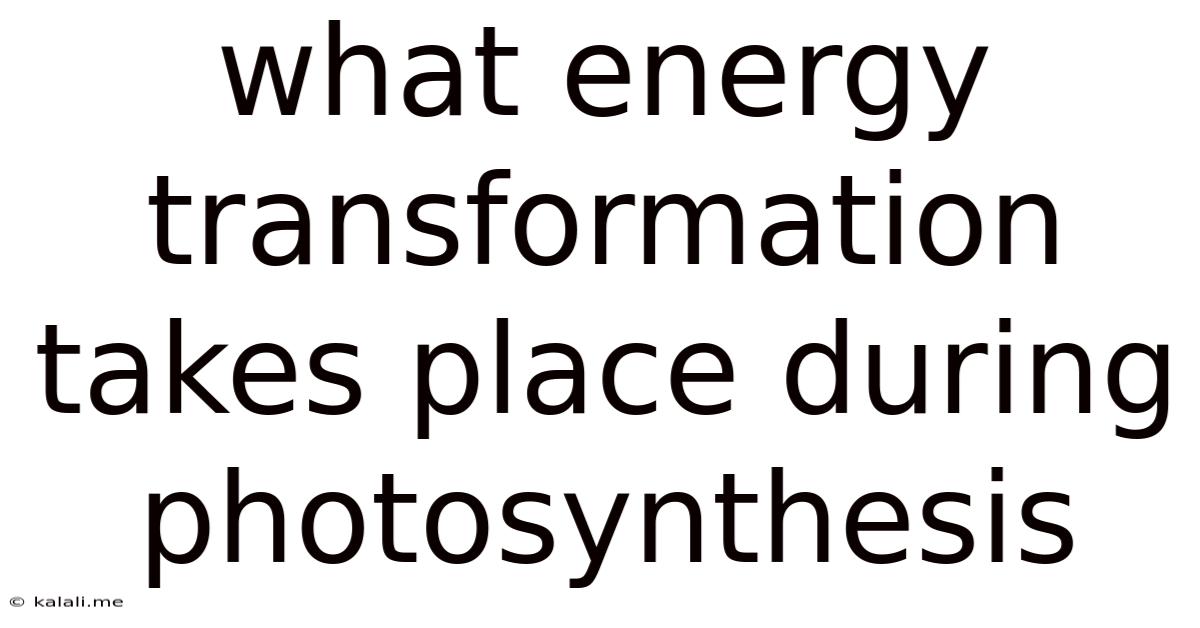What Energy Transformation Takes Place During Photosynthesis
Kalali
Jun 11, 2025 · 3 min read

Table of Contents
What Energy Transformation Takes Place During Photosynthesis?
Photosynthesis, the process by which green plants and some other organisms use sunlight to synthesize foods with the help of chlorophyll, is a fundamental process supporting almost all life on Earth. But what's truly remarkable is the incredible energy transformation that occurs at its heart. This article will delve into the specifics of this energy conversion, exploring the journey of light energy into the chemical energy stored within glucose.
Photosynthesis is not a single reaction, but rather a complex series of chemical reactions. The overall transformation can be summarized as converting light energy into chemical energy in the form of glucose (a sugar). This process is crucial because it allows plants to capture energy from the sun and store it in a usable form. Understanding the specifics of this energy transformation requires looking at the two main stages: the light-dependent reactions and the light-independent reactions (also known as the Calvin cycle).
Light-Dependent Reactions: Capturing Light Energy
The light-dependent reactions occur in the thylakoid membranes within chloroplasts. This stage is where the initial energy transformation happens. Here's a breakdown:
-
Absorption of Light Energy: Chlorophyll and other pigments within photosystems II and I absorb photons (packets of light energy). This absorption excites electrons within the pigment molecules to a higher energy level.
-
Electron Transport Chain: These high-energy electrons are passed along an electron transport chain, a series of protein complexes embedded in the thylakoid membrane. As electrons move down the chain, energy is released.
-
ATP Synthesis: This released energy is used to pump protons (H⁺ ions) across the thylakoid membrane, creating a proton gradient. This gradient drives ATP synthase, an enzyme that generates ATP (adenosine triphosphate), the cell's primary energy currency. This is chemiosmosis, a crucial energy transformation process.
-
NADPH Formation: At the end of the electron transport chain, the electrons are used to reduce NADP⁺ to NADPH. NADPH is another important energy-carrying molecule used in the next stage of photosynthesis.
In summary, the light-dependent reactions convert light energy into chemical energy stored in the high-energy molecules ATP and NADPH. This is a key energy transformation; light energy, a form of radiant energy, is converted into the chemical potential energy stored within the bonds of ATP and NADPH.
Light-Independent Reactions (Calvin Cycle): Building Glucose
The light-independent reactions, also known as the Calvin cycle, take place in the stroma of the chloroplast. Here, the chemical energy stored in ATP and NADPH is used to synthesize glucose from carbon dioxide.
-
Carbon Fixation: Carbon dioxide from the atmosphere is incorporated into an existing five-carbon molecule (RuBP) through a process catalyzed by the enzyme RuBisCO. This forms a six-carbon molecule that quickly breaks down into two three-carbon molecules (3-PGA).
-
Reduction: ATP and NADPH from the light-dependent reactions provide the energy and electrons to convert 3-PGA into G3P (glyceraldehyde-3-phosphate), a three-carbon sugar.
-
Regeneration of RuBP: Some G3P molecules are used to regenerate RuBP, ensuring the cycle continues.
-
Glucose Synthesis: Other G3P molecules are used to synthesize glucose and other carbohydrates. This is the final product of the energy transformation process.
The Calvin cycle uses the chemical energy from ATP and NADPH to convert inorganic carbon (CO₂) into organic molecules (glucose), effectively storing the energy initially captured from sunlight. This represents another crucial energy transformation – chemical energy (in ATP and NADPH) is converted into the chemical energy stored in the bonds of glucose.
Overall Energy Transformation in Photosynthesis
In essence, photosynthesis is a remarkable example of multiple energy transformations. It's a finely tuned process that efficiently converts radiant energy from the sun into the chemical energy stored in glucose, the primary fuel for most life on Earth. This energy is then available to the plant (and subsequently to organisms that consume the plant) for growth, reproduction, and all other life processes. The process involves several steps, all working together in a finely orchestrated dance of energy conversion, highlighting the elegance and efficiency of nature's design.
Latest Posts
Latest Posts
-
If I Was Born In 1977 How Old Am I
Jul 01, 2025
-
How Many Kisses Fit In A 32 Oz Jar
Jul 01, 2025
-
How Many Cups Are In 18 Oz
Jul 01, 2025
-
Do The Contestants On Naked And Afraid Get Paid
Jul 01, 2025
-
How Many Yards Are In 7 Feet
Jul 01, 2025
Related Post
Thank you for visiting our website which covers about What Energy Transformation Takes Place During Photosynthesis . We hope the information provided has been useful to you. Feel free to contact us if you have any questions or need further assistance. See you next time and don't miss to bookmark.